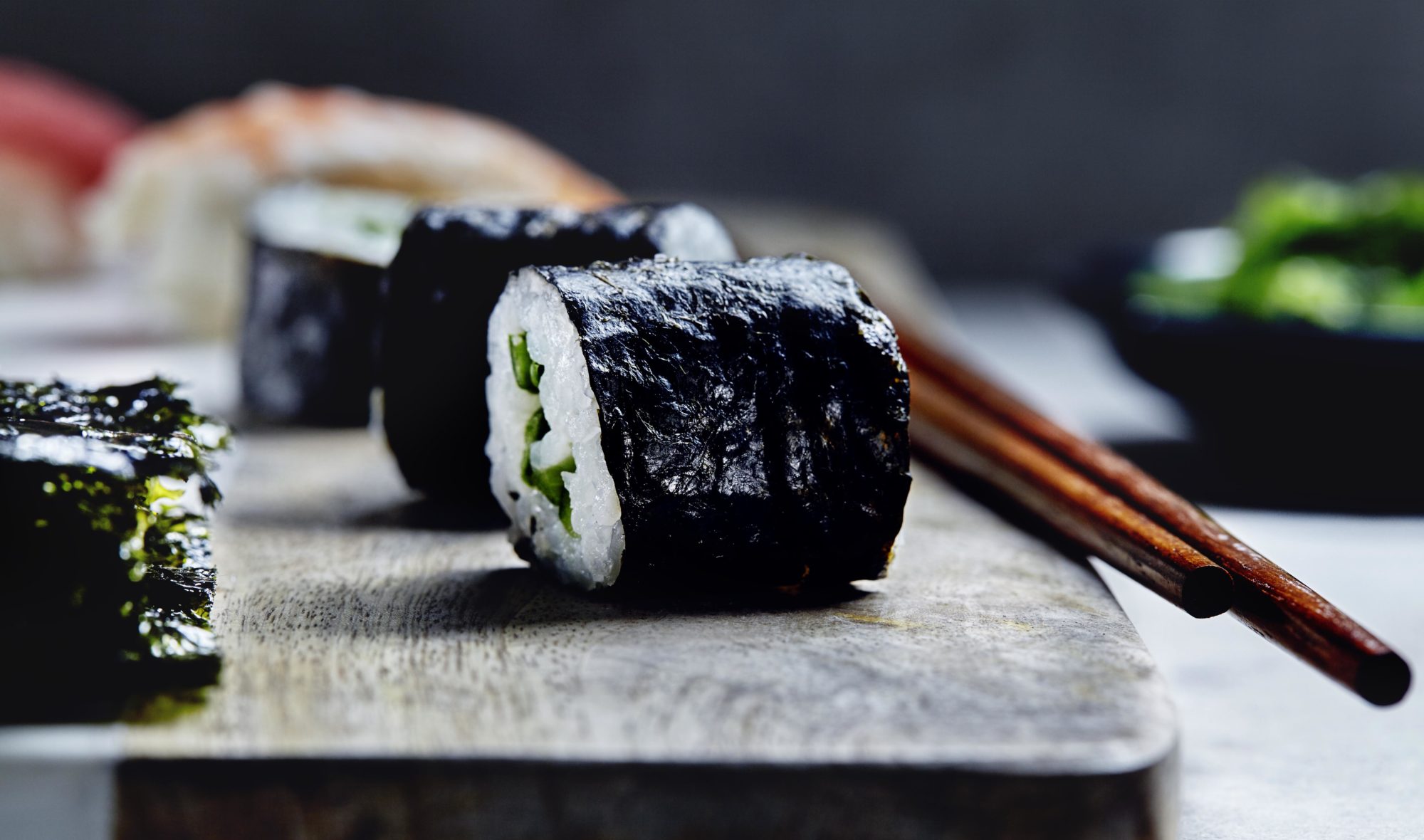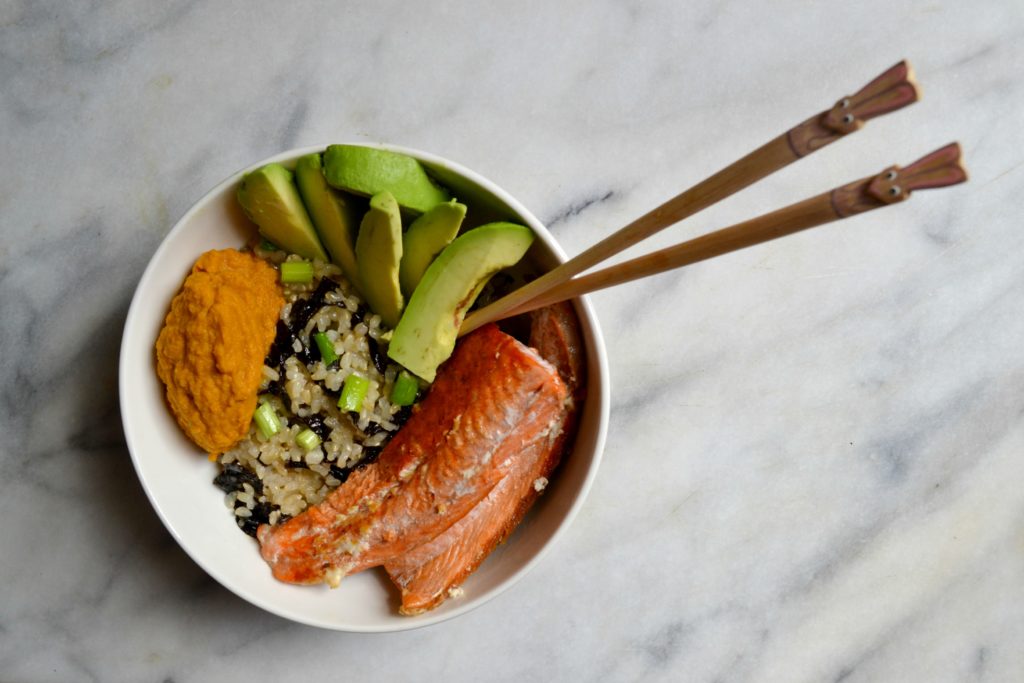
💥 Lowest price possible: on the Nutrition Coach Starter Package. Limited # left.

Nori is a dehydrated, pressed seaweed that comes in thin, paper-like sheets. It has a mild, sea-like flavor, and is a natural source of iodine and B12, as well as other micronutrients such as vitamin C, magnesium, and potassium. Most commonly used in sushi, nori can be added to other dishes to provide some crisp texture and an extra dose of nutrients. Roasted and seasoned, nori makes for a great stand-alone snack.
Nori is a dehydrated, pressed seaweed of the edible red algae species. This sea vegetable is grown in the waters off Japan, Korea, and China.
Nori is common in Japanese cuisine: most notably sushi. If you’ve ever had “maki”, or sushi rolls, you’ve eaten nori: it’s the black, thin sheet that wraps the sushi roll together.
Naturally salty with a mild sea-like taste, it has a savory, “umami” flavor.
Nori is black and comes in paper-like sheets. Unlike some kinds of seaweed, it’s smooth and thin in texture, with a mild smell and flavor.
Because there are many kinds of seaweed available, check the package to be sure you are buying nori. Note that nori is sometimes called “Laver seaweed”.
Nori is very low in calories. Ten sheets of nori (approximately 26 grams) contains only 9 calories as well as 1.5 grams of protein, 1.3 grams of carbohydrates, 0.1 grams of fiber, and 0.1 grams of sugar.
Because it absorbs the minerals in which it is grown, nori offers a host of vitamins and minerals including iodine, vitamin C, potassium, vitamin A, magnesium, calcium, iron, zinc, and even vitamin B12 (rare in plant foods).
When looking for nori, head to the Asian section of your supermarket. You may also try a health foods store or an Asian market if you have trouble finding it.
When buying, check the expiry date on the package to make sure it’s fresh.
Depending on how you plan to eat the seaweed, one option is pre-seasoned nori, often packaged and marketed as “seaweed snacks,” or “roasted seaweed”. These come in small, easy to eat sheets. (Note: be aware that these often contain added ingredients such as oil and salt. Check the ingredients list first so you know what you’re buying.)
Keep nori in a cool, dark place such as your pantry. Stored properly in an unopened package, it will usually last for about six months.
Nori is best used within several days of opening, as it will start to turn stale after being exposed to air. Stale nori is chewy rather than crisp. After opening, keep nori in a sealable plastic bag and use as soon as possible.
Use nori to make your own sushi, use nori sheets as a wrap for sandwiches, or slice into thin ribbons and use as a topping for salad, rice dishes, fish, noodles, or soup.
To make your own ‘seaweed snacks,’ lightly brush the nori with water. Add a sprinkle of extra flavoring if you like (e.g. sesame seeds, sea salt, and / or wasabi powder) and bake in an oven on low – about 10 to 15 minutes at 250 degrees Fahrenheit. The nori will come out crisp and crunchy.

You don’t have to be an artful engineer to enjoy the flavors of sushi at home! All the elements of sushi come together in this humble yet delicious bowl. Use the carrot sauce as a dip for various bowl elements or mix everything together and devour.
Prep Time: 15 minutes Cook Time: 20 minutes Yield: 1 sushi bowl and 4 servings of sauce
For the Sauce:
Place all ingredients into a high-speed blender and blend until smooth.
Use desired amount for sushi bowl, and reserve the rest. Store in an airtight container in the fridge for up to 2 days.
For the Sushi Bowl:
Place cooked rice, chopped up nori, sliced green onions, and vinegar into a bowl and toss to combine. Place prepared salmon, sliced avocado, and a few dollops of carrot ginger sauce on top.
Eat immediately.
Precision Nutrition’s Encyclopedia of Food expands every single month as we highlight new foods and showcase beautiful food photography. If you’d like to stay up to date, simply click this link. From there, we’ll send you a FREE copy of our recipe book. We’ll also let you know when new and delicious foods are added to the site.
Nori is a dehydrated, pressed seaweed that comes in thin, paper-like sheets. It has a mild, sea-like flavor, and is a natural source of iodine and B12, as well as other micronutrients such as vitamin C, magnesium, and potassium. Most commonly used in sushi, nori can be added to other dishes to provide some crisp texture and an extra dose of nutrients. Roasted and seasoned, nori makes for a great stand-alone snack.